
HOME





HOME
|

|

|

|

|
|
P R O F I L E |
||||
|
 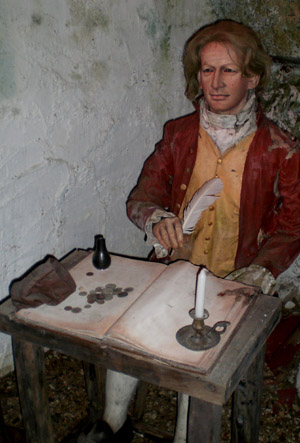 West Wycombe Hell Fire Caves Grotto
West Wycombe Hell Fire Caves GrottoWest Wycombe Park West Wycombe Buckinghamshire United Kingdom HP14 3AJ Telephone: 01494 533739 The Hell-Fire Caves grotto at West Wycombe comprises a long, winding tunnel into the chalk hillside with a variety of chambers and passages leading to the Inner Temple. It was constructed in a chalk quarry in the 1750s when excavation was taking place to secure materials for local road building. At the time follies and grottoes were fashionable and Sir Francis Dashwood saw this as an opportunity to enhance his estate with not only roads but also a grotto. 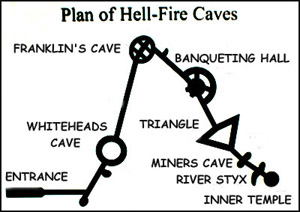 The result was a complex that burrowed into the hillside beneath the church and mausoleum. It encapsulated Greek mythology by including the River Styx, which separated the earth from the underworld. To enter the Inner Temple you crossed the subterranean river, implying that this was Hell. Three hundred feet above was the church and mausoleum, epitomising Heaven.
The result was a complex that burrowed into the hillside beneath the church and mausoleum. It encapsulated Greek mythology by including the River Styx, which separated the earth from the underworld. To enter the Inner Temple you crossed the subterranean river, implying that this was Hell. Three hundred feet above was the church and mausoleum, epitomising Heaven.
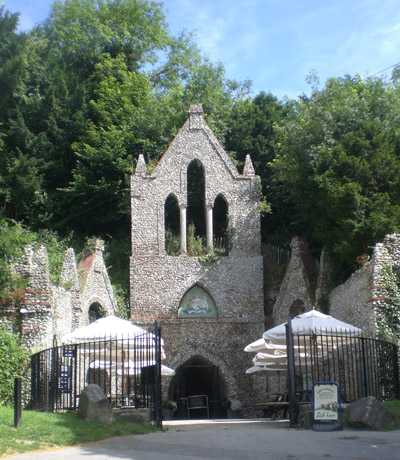 At the entrance to the grotto, Sir Francis created an imposing Gothic facade that resembled a place where your worst nightmare might take place. This daunting edifice was constructed of local flint with arches and recesses for statues. It could be seen from the main house across the valley. The Gothic theme was often associated with medieval buildings and what was seen as a dark and terrifying period, characterised by harsh laws enforced by torture, and with mysterious, fantastic, and superstitious rituals. In literature such Anti-Catholicism had a European dimension featuring Roman Catholic excesses such as the Inquisition. Prominent features of Gothic legend include terror (both psychological and physical), mystery, the supernatural, ghosts, haunted houses and Gothic architecture, castles, darkness, death, decay, doubles, madness, secrets, and hereditary curses. Such tales became popular in the 18th century and were subsequently enhanced by the twentieth century film industry with Dracula and other horror movies. The authors of these writings unite romanticism with horror to create a scary dichotomy in the mind of the observer.
At the entrance to the grotto, Sir Francis created an imposing Gothic facade that resembled a place where your worst nightmare might take place. This daunting edifice was constructed of local flint with arches and recesses for statues. It could be seen from the main house across the valley. The Gothic theme was often associated with medieval buildings and what was seen as a dark and terrifying period, characterised by harsh laws enforced by torture, and with mysterious, fantastic, and superstitious rituals. In literature such Anti-Catholicism had a European dimension featuring Roman Catholic excesses such as the Inquisition. Prominent features of Gothic legend include terror (both psychological and physical), mystery, the supernatural, ghosts, haunted houses and Gothic architecture, castles, darkness, death, decay, doubles, madness, secrets, and hereditary curses. Such tales became popular in the 18th century and were subsequently enhanced by the twentieth century film industry with Dracula and other horror movies. The authors of these writings unite romanticism with horror to create a scary dichotomy in the mind of the observer.
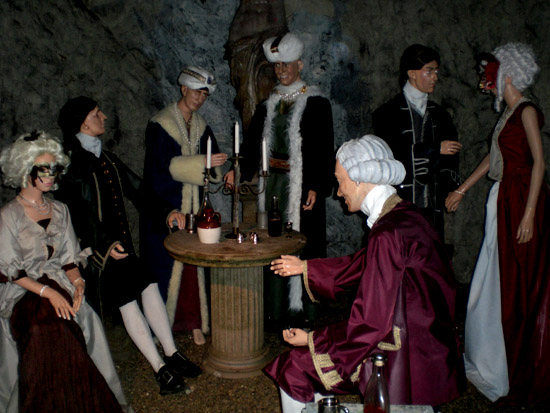
The eighteenth century Hell-Fire Club was an exclusive group of well-known personalities from government and the aristocracy. They enjoyed not only the exclusivity of a privileged membership of companions but also indulged in a variety of rituals and celebrations, some of which were deemed to be sexual in nature. Their main meeting place was Medmenham Abbey. This was restored at the time for such purposes a few miles away. 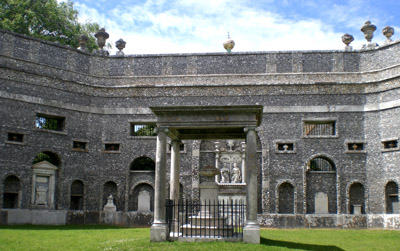 There are indications that the Hell-Fire Club also met occasionally here in the West Wycombe Caves and there is the suggestion that debauchery took place underground. These meetings were likely laid on by the then current Sir Francis who probably saw such occasions as a party of friends rather than a formal meeting of the Club. No doubt dressing up and various entertainments added to the ambiance of the occasions. As for sexual activities however, an underground chamber would hardly have been the most comfortable place for such personal liaisons. There are indications that the Hell-Fire Club also met occasionally here in the West Wycombe Caves and there is the suggestion that debauchery took place underground. These meetings were likely laid on by the then current Sir Francis who probably saw such occasions as a party of friends rather than a formal meeting of the Club. No doubt dressing up and various entertainments added to the ambiance of the occasions. As for sexual activities however, an underground chamber would hardly have been the most comfortable place for such personal liaisons.
By World War II the grotto was in a dilapidated state. This was aggravated by the removal of the 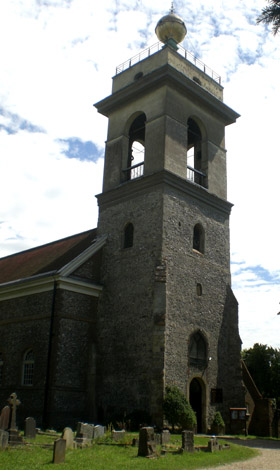 front facade to form a bomb blast bank when the grotto became an air raid shelter for local villagers. In 1951 the then current Sir Francis Dashwood started a long process of restoring the grotto and the public were admitted for a nominal sum albeit on a small scale. Amidst the wave of publicity this project created, the local vicar Father Allen publicly denounced the evil influence that emanated from the cave that made him feel ill whenever he passed the entrance. Not to be outdone by such superstition, Sir Francis and an ever increasing band of helpers pursued their restoration intentions. Much of the underground caverns and passages were clearly unsafe and rock falls were an alarming feature as work over the years progressed. In 1973 fresh impetus was applied to the long term restoration programme by including making safe the areas where rock falls had taken place. Today the public can enjoy the benefits of this long term endeavour. front facade to form a bomb blast bank when the grotto became an air raid shelter for local villagers. In 1951 the then current Sir Francis Dashwood started a long process of restoring the grotto and the public were admitted for a nominal sum albeit on a small scale. Amidst the wave of publicity this project created, the local vicar Father Allen publicly denounced the evil influence that emanated from the cave that made him feel ill whenever he passed the entrance. Not to be outdone by such superstition, Sir Francis and an ever increasing band of helpers pursued their restoration intentions. Much of the underground caverns and passages were clearly unsafe and rock falls were an alarming feature as work over the years progressed. In 1973 fresh impetus was applied to the long term restoration programme by including making safe the areas where rock falls had taken place. Today the public can enjoy the benefits of this long term endeavour.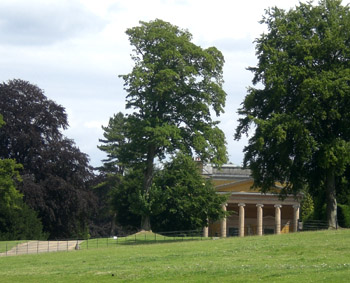
Further Reading: West Wycombe Caves (undated but available in 2014) Visitor Guide. The Dashwoods of Wycombe, (1987) Sir Francis Dashwood, Aurum Press, London. Illustrations: (1-8 sequencing) 1. The Cave Steward. 2. The Sytx River, the legendary river that needs to be crossed to enter the Inner Temple, either by boat or by bridge. 3. The Nun. Nuns reputedly haunt the grotto and ladies of the night were said to have worn such attire when attending the club members in the caves. 4. 5. Banqueting Hall figures add mythology to dining. 6. Venus locked away behind bars. 7. Sir Francis Dashwood entertains Benjamin Franklin in the caves. 8. The Styx River in Greek mythology formed the boundary between Earth and the Underworld. 9. Plan of the grotto. 10. The Gothic Facade. 11. Party in the Inner Temple. Just visible - Venus looks out of the gloom behind. 12. The Dashwood Mausoleum, above the caves - a transition point for the soul on its way to Heaven. 13. The church with the golden ball symbolising the way to Heaven. 14. The main mansion, nestling in the trees some distance away from the conflict between Heaven and Hell symbolised by the buildings on the hill across the valley and yet near enough to keep an eye on what is going on. 15. Map of the Estate showing the Grotto positioning. 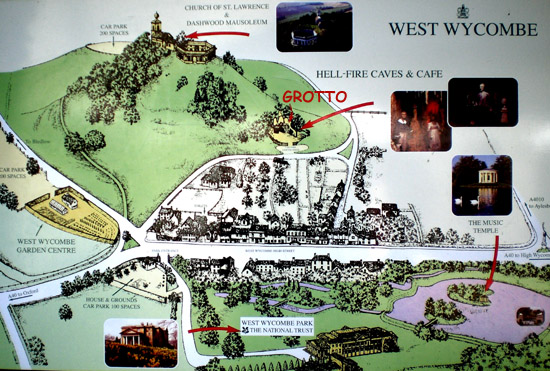
Website: Click Here ADDITIONAL INFORMATION 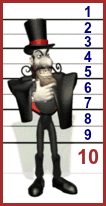 
GREAT BRITISH GROTTO GRADING
CONSTRAINTS On private property, Open set times only FACILITIES Access by Road, Access on Foot, Entry Fee, Grotto - just one, Restaurant/Food, Retail Souvenir Shop, Toilets, Tourism Information LANDSCAPE Country town/village, Rural REGION England - Central THE FEATURES PRESENT +A created provenance that links it to ancient mythology or legend, +Cared for and maintained in good condition, +Crystals and/or minerals, either natural or simulated, +Dark and mysterious chambers and cave like spaces, +External rock structures, either real or simulated, +Internal stonework that is natural, recycled or simulated to give a subterranean decor, +Sacred spring or integral water feature, +Stunning setting and location, GRADED EIGHT |
||||
|